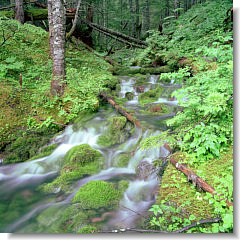Module 3 - Stand level components of forest biodiversity
Overview of module 3
There are six stand level components (attributes) of forest biodiversity. These six contribute together and to a lesser extent, singly to the biological diversity at the forest stand level. They represent selected attributes that comprise the primary strategy for maintaining stand-level biodiversity in British Columbia.
Because Module 3 is very long, it is divided into seven major parts:
- Stand structure
- Wildlife trees
- Coarse woody debris
- Forest floor
- Special habitats
- Tree & vegetation species composition
- Related topics & module closure
See also Appendix 1 — Soil biodiversity
Learner outcomes
On completion of this module, you will understand the role that the stand level components play in forest biodiversity and you will be able to
- Describe the six stand level components
- Identify the applications for forest management for the six stand level components
- Describe the role of the stand level components in forest biodiversity
The next three outcomes can only be achieved if you complete the assignments.
- Assess an old growth forest using the six stand level components as tools
- Formulate recommendations for managing a harvested site
- Prepare a plan for harvesting a site using good stand level biodiversity management practice
Pre-reading questions
The following questions will determine how much you already know about the six stand level components of forest biodiversity. It is suggested that you use a mind map to assist you in remembering.
- Define the term, stand level
- Define the term, structural attributes
- What do you already know about each of the six stand level components?
-
List and describe each of them
- Describe the applications for forest management for each of the six stand level components
- What do you know about:
- Stand level components
- Wildlife tree patch composition
- Individual live tree retention
- Creating wildlife trees
- Stubs
- Tree topping
- Standing dead trees
- Blasting
- Stem girdling
- No-Work Zones
- Calculating wildlife tree patch areas
- Record keeping and inventory used in wildlife patches and other stand level components
- Worker safety issues utilized in wildlife tree retention in the harvesting operations and other stand level components
- Management strategies within forest diversity
Module Assignments
These three assignments are to be used as applications of the content. Treat them as self-evaluations of what you have either remembered or learned in this module. As an adult learner, it is very important that you apply what you learn. These assignments are added as an enhancement to the course. They are optional. Do all or as many as possible before you move on to another module.
A. Visit an old growth forest to:
- Identify examples of the six stand level components (attributes)
- List the physical features of each of the six stand level components that you used to label them
- Identify the features of each that are important for biodiversity
- Be able to justify your answers
- Is this list different from the first list that you used to identify the six stand level components (Q. #1)? If so, how, if not, why not?
- How important are these features to forest workers? Explain
-
Using Figure 8 (British Columbia's wildlife tree classification system), locate several examples of each of the nine classes of trees
-
Describe the safety and operational constraints associated with conserving the features of each of the six stand level components (attributes)
-
Discuss if all of the six stand components need to be managed for biodiversity
-
Which of the six stand components provide the most biodiversity? Explain
-
Identify the worker safety issues for each of the six stand components
-
Describe how a forest manager would/should handle the six stand components
B. Visit a site harvested within the past 1 – 3 years to:
- Describe the site
- Determine if any attempt has been made to manage the biodiversity features
- If yes, describe what was done
- If yes, assess how successful was it?
- Formulate recommendations for further management strategies (for example, if too much CWD is left on the site what would you recommend and why?)
C. Visit a site that will be harvested in the near future to:
- Describe the site
- Formulate a plan for harvesting it
- Consider silvicultural objectives
- Consider stand level biodiversity issues
- Consider harvesting issues
- Consider worker safety issues
When you have completed one or more of the assignments, you should ask someone to read and then discuss it/them with you. Their feedback will likely be very valuable to you.
Module Directions
The questions on the left side of the page are to assist you in keeping actively involved in the material and your learning. Answer them silently or write out the answers.

A forest showing components of biodiversity.


